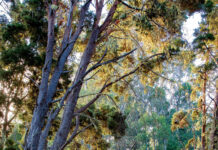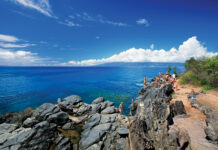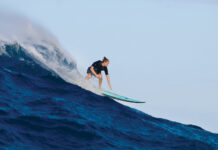Story by Sky Barnhart | Photography by Jason Moore
 I learned a new word today. Cruiser. Not the car you can buy for 500 bucks and drive around the island twice before it conks out. This kind of cruiser is a person—someone who’s living out the fantasy of everyone who’s ever felt the wind through the sails of a sailboat.
I learned a new word today. Cruiser. Not the car you can buy for 500 bucks and drive around the island twice before it conks out. This kind of cruiser is a person—someone who’s living out the fantasy of everyone who’s ever felt the wind through the sails of a sailboat.
Cruisers live aboard their sailboats and sail around the world (or at least island-hop). They eat, sleep and work onboard their boats, visiting new ports of call like the sailors of old—but with a little more technology and some pretty good maps.
Kula residents LuAnne and Rob Yapp are cruisers. In May, they sailed the Compass Rose, their forty-two-foot Hunter 420 sailboat, from Florida to the Virgin Islands. They left the boat in Saint Thomas to come home to Maui for the birth of a grandchild, then returned in August to sail to the Windward and Leeward Islands in the Caribbean. Their goal: to make it to Aruba or Bonaire by December, then home to Maui . . . then maybe to Tahiti.
“Living aboard is quite an adventure,” LuAnne says. “A lot of people have this romanticized view of it—all sunsets and happy hours—but sailing really is a lot of work, from the time you get up to when you go to bed. Even in a fairly new boat, something breaks almost daily.” Things like the webbing at the peak of the jib (the small sail in front of the mast)—requiring an unscheduled stop in the Bahamas for repairs.
Fixing stuff onboard is all part of the sailing lifestyle, even if you’re a day sailor and not a cruiser, according to Martin Ames, captain of the America II out of Lahaina Harbor.
“You have to be like MacGyver and stay on your toes,” Ames says. “Sailing never gets monotonous or old—it’s never boring. I learn something new every day.”
I’m already learning a lot of new things in my first hour aboard the America II. I’ve come on a two-hour sail to get a taste of the cruising lifestyle, to imagine what it’s like to live aboard a sailboat for days and weeks at a time. Granted, this is a performance boat, not really a cruising boat. This sixty-five-foot yacht sailed in the America’s Cup race in Fremantle, Australia, in 1987, crewed by professional sailors and reaching speeds of up to twenty knots (that’s fast, in sailing terms).
She’s a gorgeous boat and still sleek despite retrofitting with benches and safety rails to meet Coast Guard requirements for passenger vessels.
With twenty people onboard, there’s not much room to stretch out as we motor out of Lahaina Harbor. When we get out to the wind line, First Mate Robert Smith asks for volunteers to help put up the mainsail.
I scramble up on the deck and, at his instruction, grab the thick striped rope, using all my weight to pull it down. The wind whips my ponytail across my face, and I can feel the sting of the rope on my palms. The regal white sail cranks upward, unfurling against the blue sky. It’s a beautiful sight!
With her sail up, the America II springs to life, catching the wind and lunging gladly forward. Ames is using a “close-haul” point of sail, sailing almost directly into the wind all the way up to Ka‘anapali. The boat starts to lean on her side. “It may feel like we’re going over, but she’s not going to tip with twenty-one tons of lead in her keel!” Ames shouts.
I brace my feet against the bench in front of me. The people on the other side of the boat are almost lying on their backs. They’re smiling. We’re all smiling. Water sprays up over the prow, drenching my shoulders, but the sun is warm.
I suddenly realize that it’s quiet out here. No motor, no chuff-chuffing—just the wind whistling through the sails, the creak of the mast above and the splash of waves over the bow.
But quiet as it is, it’s not exactly peaceful—it’s an active quiet. Ames never takes his attention from the sailboat’s prow. Behind his sunglasses, his eyes, even while he talks to passengers, scan the horizon, his hands skimming the big wheel.
This kind of vigilance is something LuAnne knows well. “If you’ve got your sails up, you need to watch the sails; somebody has to be at the helm at all times,” she says.
In the first leg of their journey from Florida, LuAnne and Rob needed to make up time by sailing at night as well as in daylight. “With only two people onboard, you’re taking two-and-a-half-hour watches, so you’re not getting a lot of sleep,” LuAnne says. “Plus you worry about being thrown overboard. We wear safety harnesses at night so we’re attached to the boat.”
Safety is an integral part of the sailing lifestyle. For avid Lahaina sailor Keahi Ho, safety is all about understanding and awareness of the ocean environment. “You’ve gotta have a level head to get yourself out of tough situations and the foresight to see what’s going to happen ahead of you,” he says. “It’s also about not taking risks that you’re not prepared to deal with, and not jumping off the cliff blindfolded.”
For the last ten years, Ho and his wife, Kaeli, have sailed in the annual Lahaina Return Race from Maui to Honolulu. The seventy-mile race typically takes six to ten hours.
“Sailing has always been my passion and my dream, and I do as much of it as I possibly can,” Keahi says. “I try to include my family, too, just teaching and sharing it with my kids [Mihana, seven; Nalu, five; and Tepua, three].”
The biggest challenge to sailing on Maui, according to Keahi, is lack of facilities. Slips at the island’s harbors are hard to come by.
When you do have a slip, you end up spending a lot of time there, according to LuAnne.
“When we have the boat in Lahaina, it’s an every-weekend job,” she says. “We hose the boat off, do routine maintenance, dive down and clean the bottom—real glamorous stuff!”
Then there’s the danger. Storms are a biggie. Every sailor has a storm story to tell.
Keahi tells of facing a storm 300 miles offshore of California, with forty-foot waves and winds up to forty knots. “The boat was fast, so we turned downwind and just surfed these forty-foot bombers all night,” he says.
First Mate Smith went through a typhoon in the Navy. “I like sailing to weather [toward the wind], sailing hard,” he says. “I like the sense of adventure.”
“If you’re out where you can’t seek shelter, you just have to weather it,” LuAnne says. “For really bad weather, we have a sea anchor and droge [a small parachute used to slow the boat in high wind and seas], but we haven’t had to use them. You just take down all your sails and hunker down.”
Fortunately for those of us on the America II, I don’t think we’ll need any sea anchors or droges today. As we draw even with Pu‘u Keka‘a, the massive outcropping on Ka‘anapali Beach known colloquially as Black Rock, Ames jibes, turning the stern of the boat through the wind, and the vessel levels out. I sigh with relief and stretch my legs out of their braced position. I don’t know if I’m cut out to be a cruiser.
The crew passes out cold sodas and snacks, and everyone relaxes as we head back down the coast on a broad reach (sailing far away from the wind, but still filling the mainsail and jib).
I watch the crew moving among the lines and sails, winding ropes, spinning the huge wheel. They are tanned and fit, at ease on the deck as they are on land.
“Sailors are usually pretty active people,” LuAnne says. “It’s all pretty physical—every minute you spend on a boat, you’re compensating for its movement, so your muscles are constantly working.”
Other qualities needed for cruisers and sailors: patience (important in getting along with other crewmates in a very small space), a good sense of humor (same reason), organization (planning for long trips), minimalism (spending your days in shorts and a swimsuit)—and you have to like fish.
“During our trip through the Bahamas, we fished every day. Rob caught a 175-pound marlin off the coast of the Dominican Republic,” LuAnne says. “We ate nothing but fish for a month!”
The America II has a fishing line running behind the boat, but so far no luck today. “We caught twenty-five mahi a few weeks ago; we were giving fish to everyone we knew,” Smith says.
Suddenly, a shape appears in the wave streaming off the prow. A big bottlenose dolphin playfully arches its back, matching the speed of the sailboat.
Maybe I could be a cruiser after all. . . .
Set Sail!
Maui’s many sailing companies offer sailing, snorkeling, sunset sails, whale watches (in season) and private charters. Just remember to think “minimalistic,” and leave that expensive new video camera at home—unless it’s waterproof!
America II
This sixty-five-foot yacht challenged Dennis Connor in Fremantle, Australia, in America’s Cup racing in 1987. Departs from Lahaina Harbor. 667-2195
www.sailingonmaui.com
Kapalua Kai
This fifty-three-foot, high-performance sailing catamaran offers two daily excursions departing from Ka‘anapali Beach. 665-0344 or 667-5980
www.sailingmaui.com/kapkai.html
Paragon
Twin vessels Paragon and Paragon II are high-performance sailing catamarans owned and operated by the Barto family. Depart from Ma‘alaea and Lahaina Harbors. 244-2087 or toll-free (800) 441-2087
www.sailmaui.com/about.htm
Scotch Mist
The Scotch Mist II is a Santa Cruz 50 sailing yacht, built for the 1984 Victoria– Maui International Yacht Race (she was first to finish). Departs from Lahaina Harbor. 661-0386
www.scotchmistsailingcharters.com
Shangri-La
This sixty-five-foot luxury sailing yacht offers custom-designed private sailing charters from Ka‘anapali Beach.
665-0077 or toll-free (888) 855-9977
www.sailingmaui.com/shangrila.html
Trilogy
The oldest family-owned sailing company on Maui operates a fleet of custom high-tech sailing catamarans. Depart from Ma‘alaea and Lahaina Harbors and Ka‘anapali Beach.
Toll-free (888) 225-MAUI (6284)
www.sailtrilogy.com
West Maui Sailing School, Inc.
For the do-it-yourselfer: Sail sixteen-foot Hobie Cats. Rides, lessons and rentals from Ka‘anapali Beach.
667-5545
Sailing Resources
Lahaina Yacht Club
661-0191
www.lahainayachtclub.org





